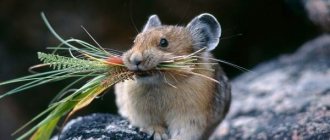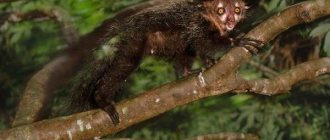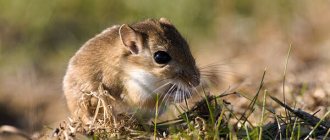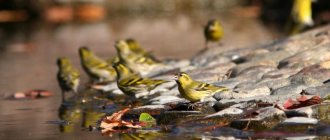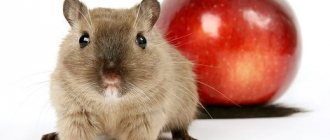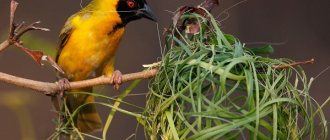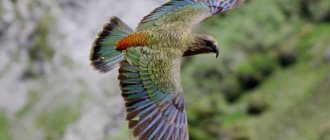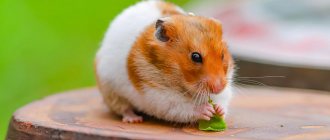Description of the rodent
Red hamster eats a leaf
– Advertisement –
Hamsters are small rodents with a dense build, short legs, small ears and short tails. The body length ranges from 5 to 34 cm, the tail is from 0.7 to 10 cm in length. Females can exceed males in size. The fur is thick, the back is colored from ash or brownish-gray to dark brown-ochre. The abdomen is found in black, white or gray. There is a pronounced black stripe on the back. Hamsters also differ from other types of rodents in having well-developed cheek pouches.
Video “Forest black hamster”
This video was shared by a summer resident who accidentally came across an amazingly beautiful forest black hamster in his garden.
Was this article helpful?
Thank you for your opinion!
The article was useful. Please share the information with your friends.
Yes (100.00%)
No
X
Please write what is wrong and leave recommendations on the article
Cancel reply
Rate the benefit of the article: Rate the author ( 8 votes, average: 4.88 out of 5)
Discuss the article:
Hamster nutritional features
A hamster eats corn at a small table.
Hamsters are omnivorous rodents, but their diet is dominated by plant foods. In addition, hamsters feed on insects and their larvae, small vertebrates (mice, reptiles and amphibians). In the autumn, they switch to seeds and tubers, and also store them in quantities from 0.5 to 11-16 kg. Sometimes hamsters' storerooms with grains and potatoes reach 90 kg. Hamsters also bring grain, peas, rice, millet, buckwheat, lupine, corn, lentils, potatoes to the pantries, putting different varieties of seeds separately. The hamster feeds on these reserves in the winter, temporarily waking up from hibernation, and in the spring until fresh food becomes available.
The hamster carries food in its cheek pouches, which contain about 46 g of wheat. Can carry food for about 1 km.
What do hamsters eat and what do they eat?
In the wild, these animals are rodents, which means that hamsters eat mainly grains. They are also always not averse to eating tender young shoots of plants, such as bamboo. In addition to cereals, the animal loves vegetables (potatoes, pumpkin, beets, carrots) and can even harm garden plantings. In order not to lack protein, the animals also periodically eat small creatures - insects, worms and even snakes. The rice hamster happily eats fish, the remains of which are left over from the dinner of other animals. Membranaceous often feasts on mollusks and crustaceans. Sleepy - Can't resist avocados and figs.
Hamster spread
— Advertising —
Hamster distribution map
Hamsters are widespread in Central and Eastern Europe, Asia Minor, Syria, Iran, Siberia, Mongolia, northern China and Korea.
The largest populations live in the forest-steppe and steppe. In the south it prefers damp areas, such as river valleys. In the mountains it is found at altitudes up to 3600 m above sea level, up to mountain meadows and forests. It also develops cultivated areas, such as rice fields, forest belts, parks, orchards, vegetable gardens, and residential buildings. Prefers dense soils, rare on sandy soils.
Water treatments and nail trimming
Hamsters do not like to bathe, so water procedures should be used only when necessary. For bathing, a special shampoo for rodents is best, after which the fur should be blotted with a soft towel. If the room is cool and you are worried that it will freeze, you can lightly dry it with a hairdryer using a gentle stream of warm air.
Overgrown claws are cut off with great care using a special nail clipper or nail clippers.
flickr/pyza
Common types of hamster
Common hamster (Cricetus cricetus)
A common hamster emerges from its burrow.
The body length of adult males is 27-34 cm, the tail is 3-8 cm long, weight is about 700 g. The tail becomes thinner towards the end, covered with short, stiff hairs. The ears are short and dark. The fur is thick and soft. The color is bright and contrasting. The back is reddish-brown, the belly is black. On the sides there are two large light spots separated by black fur. There are also light spots on the sides of the head and behind the ears. There are specimens that are black or black with white spots on the legs and neck. In total, more than 10 subspecies of the common hamster have been described. The color becomes lighter from north to south, body size increases from west to east and from north to south.
The species lives in the meadow and forest-steppe of Eurasia from Belgium to Altai and Northern Xinjiang.
Syrian hamster, or Central Asian hamster (Mesocricetus auratus)
Syrian hamster in its burrow
Body length is about 13 cm, tail up to 1.5 cm. Weight ranges from 100 to 125 g. The fur is soft, thick, golden.
It is found in nature near the Syrian city of Aleppo and in eastern Turkey.
Brandt's hamster or Transcaucasian hamster (Mesocricetus brandti)
The Caucasian hamster hides in the grass.
Body length is 15-18 cm, tail length is 2-3 cm. Weight is up to 300 g. Ears are small. The back is earthy brown. The belly is brownish-gray, there is a black spot on the chest. The sides of the head are yellowish-red, there are long black spots under the ears, and the chin is white. Paws are white. The fur is soft and thick on the tail.
The species' habitat includes Turkey, Israel, Lebanon, and the eastern Ciscaucasia. Inhabits steppes on mountain slopes, mountain meadows and cultivated areas.
Radde's hamster or Cis-Caucasian hamster (Mesocricetus raddei)
Radde's hamster in the grass - photo
Body length up to 28 cm, tail length about 1.5 cm. The back is brownish. The belly is black or dark gray. There are light spots on the cheeks and behind the ears.
Distributed in Georgia and Russia, in the North Caucasus, in the Stavropol Territory and in the Ciscaucasia, in the steppes and forest belts.
Newton's hamster (Mesocricetus newtoni)
Newton's hamster in the steppe
Body length 14-17 cm, tail length up to 2 cm, weight 80-150 g. The back is gray-brown, with a black stripe running down the center of the back. The neck and chest are black-brown, the belly is yellowish-gray.
Found along the Danube, in Bulgaria and Romania.
Djungarian hamster (Phodopus sungorus)
Djungarian hamster
Body length up to 10 cm, weight 35-65 g. Gray back decorated with a dark stripe, short tail. Fur with white spots.
Inhabits dry steppes and semi-deserts in the south of Western Siberia, Dzungarian Alatau, and Khakassia.
Campbell's hamster - photo
(Phodopus campbelli)
Body length is 7-10 cm, the tail is short, up to 1.5 cm long, weight is about 25 g. The head is rounded, the muzzle is short. The fur is dark gray with a brown tint, there is a dark stripe on the back, and the belly is gray.
The species is distributed in Mongolia, northern China, Russia and Kazakhstan.
Roborovski's hamster (Phodopus roborovskii)
Roborovsky hamster photo at home
A small species with a body length of 4-5 cm, weighing about 30 g. The head and back are sandy-golden, the abdomen is white. Light spots are visible above the eyes.
Found in Mongolia, China and Russia.
Short-tailed hamster (Cricetulus alticola)
Short-tailed hamster in the grass
Body length is 8-10 cm, weight ranges from 22 to 48 g. The fur is gray-yellow-brown without spots.
It lives in the north of South Asia and China, at altitudes of about 4000 m above sea level, in coniferous and birch forests, and in the steppes.
Barabinsky hamster (Cricetulus barabensis)
Barabinsky hamster - photo
Outwardly similar to an ordinary hamster. Inhabits forest-steppe and semi-deserts in the south of Western Siberia, Tuva, Transbaikalia, Mongolia, northeast China, Primorye (Russia) and Korea.
Gray hamster (Cricetulus migratorius)
Gray hamster in the steppe - photo
Body length 10-13 cm, tail 2-3.5 cm long. The coat is gray on top, the abdomen and tail are light. The eyes are large. The ears are small.
The species' habitat includes Eastern Europe, Russia, Asia to western China.
Sokolov's hamster (Cricetulus sokolovi)
Sokolov's hamster on a stone
Body length from 7 to 11 cm, tail length up to 3 cm. The back is gray with a dark stripe. The abdomen is light gray. There are dark brown spots in the center of the ears.
Found in sandy areas of Mongolia and China.
Mongolian hamster (Allocricetulus curtatus)
Mongolian hamster in the Berlin Zoo
A small species with a body length of 10-15 cm, a tail 1.5-2 cm long. The color is light, the tummy, tail and paws are white. The tail is fluffy.
It lives in the Zaisan depression in the south of Tuva, China and Mongolia.
Eversman's hamster (Allocricetulus eversmanni)
Eversman's hamster - photo
Body length 13-16 cm, tail 2-3 cm long. Legs short. The ears are small. The tail is wide, flattened, densely pubescent. The fur is short, soft, velvety. The back is blackish-brown or fawn-red or ash-sandy. The belly is white with a sharp border on the sides. There is a brown spot on the throat and chest. The paws and tail are white below.
Lives in the Lower and Middle Trans-Volga region, in the south of the Trans-Urals, in Kazakhstan.
Kansky hamster (Cansumys canus)
The Kansky hamster lies on its stomach.
Body length is from 10 to 17 cm, tail is 7-10 cm. Weight is from 60 to 120 g. The fur is thick, the back is gray with white spots on the cheeks and near the ears. The belly and tip of the tail are white.
The species is distributed in central China.
Rat-like hamster (Tscherskia triton)
Body length from 14 to 25 cm, tail 7-10 cm long. Weight from 92 to 241 g. The back is light gray-brown, the tail is dark brown with a white tip, the paws are white.
The habitat includes northeast China, the south of Primorsky Krai, and Korea.
Origin of the species and description
Photo: Syrian hamster
The Syrian hamster is a chordate animal. They are classified into the class of mammals, the order Rodents, the family Hamsters, the genus Medium hamsters, and the species Syrian hamsters. Initially, the name golden hamster was assigned to them thanks to zoologist Georg Robert Waterhouse. On the recommendation of Charles Darwin, he compiled a list of animals that arrived from the expedition on the Beagle. Among the diversity of representatives of the animal world, there was the only representative of this breed.
Video: Syrian hamster
This species of animal was first described by the English scientist, zoologist and researcher George Robert Waterhouse in 1839. The scientist mistakenly considered it an extinct species. This assumption was refuted in 1930, when another scientist Israel Aharoni, during his expedition, discovered a Syrian hamster - it was a pregnant female. The scientist transported this hamster to the University of Judea, where the female safely gave birth to 11 small hamsters. Subsequently, of the entire brood, only three males and the female who gave birth to them remained alive.
Scientists tried in vain to find other individuals of this species in natural conditions. However, they never managed to do this. Then Akhoroni came up with the idea of crossing a female Syrian hamster with a male of a related species. This couple became the progenitors of a new species. Around 1939-40, the resulting offspring were transported to the United States of America. After another 1.5-2 years, scientists finally came to the conclusion that the Central Asian hamsters had become extinct, and there were no more representatives of this species in natural conditions.
In the process of studying Syrian hamsters, it was found that they have a dental structure similar to that of humans, and therefore they were used in laboratory conditions to study dental diseases. To date, scientists have not been able to answer the question of what caused the extermination of this species of animals.
Hamster behavior
Hamster on a walk
Hamsters are terrestrial animals; some species can swim by taking air into their cheek pouches. They usually live alone, in burrows. Outside the breeding season, hamsters behave aggressively towards their relatives and often start fights. In winter, they fall into a prolonged torpor, which is still not real hibernation.
Hamsters are characterized by a twilight lifestyle. During the day they remain in their burrows, which reach 8 m in length and 1.5 m in depth. May occupy gopher burrows. In a permanent burrow there are from 2-5, sometimes up to 10 exits, a nesting chamber and storerooms.
Character and lifestyle
By their nature, hamsters are loners, aggressive against anyone who encroaches on their territory. They protect their possessions up to 10-12 hectares in size. The size of the enemy does not matter; there are known cases of rodent attacks on large dogs.
If related rodents run away from meeting a person, steppe hamsters may attack. Rodent bites are painful, can cause infection with many diseases, and leave lacerations.
Ruthlessness manifests itself even towards its own individuals. The weaker ones will not escape alive from their strong and toothy relatives if they consider them an enemy during mating time or simply notice an unwanted guest near their reserves. The activity of the animals manifests itself at twilight. Hamsters are nocturnal animals . During the day they hide in holes, gaining strength for fearless hunting.
Deep dwellings are located 2-2 meters underground. If the soil allows, the hamster will go as deep as possible into the soil. The living chamber is equipped with three exits: two “doors” for ease of movement, and the third leads to a pantry with supplies for the animals’ winter life.
The hamster uses the accumulated food only during hungry, frosty times and at the beginning of spring. In other seasons, food consists of food from the external environment. Above the burrows there are always dug piles of earth, sprinkled with grain husks. If cobwebs have accumulated at the entrance, then the home is abandoned; hamsters keep the houses clean.
Not all hamsters hibernate; some species even turn white so that their forays into the snow cover are unnoticeable. Those who wait out harsh weather in shallow sleep periodically stay awake to refresh themselves with accumulated reserves. When the earth begins to warm up, in February, March or early April, it is time for the final awakening.
But before leaving completely, the hamster will still feast on supplies, gain strength, and then open the entrances and exits of the hole. The males emerge from the burrows first, and the females a little later.
Peaceful relations between them are established only during the marriage period, otherwise they exist on equal terms. Hamsters' ability to swim well is amazing. They inflate their cheek pouches like a life jacket that keeps them afloat.
Hamster breeding
A female hamster with her offspring
Hamsters are known for their fertility, producing 2-4 litters per year. The duration of pregnancy is from 15 to 22 days, in one litter there are from 1 to 18 babies, they become sexually mature already at the 6-8th week of life. Under natural conditions, hamsters live from 1 to 3 years, at home about 3 years.
Reproduction and raising of offspring
Hamsters become sexually mature very early. Actually, both females and males are ready for procreation, reaching two months of age. The breeding season for these animals lasts from April to October. During the winter months, hamsters become inactive and practically do not crawl out of their burrows, eating accumulated reserves. But zoologists sometimes record cases of cubs being born in December, and this usually happens during an abnormally warm and snowless winter.
Unlike their wild counterparts, domestic hamsters breed all year round, since when kept in an apartment, their home always has a comfortable temperature and enough food.
Features of the mating season
As already mentioned, in their natural environment, hamsters lead a solitary lifestyle. They do not form strong mating unions, although some males have a kind of personal “harem” consisting of 3-5 females. True, he lives in different burrows, but the females live in the controlled territory of their “husband,” and he jealously protects them from the encroachments of foreign males.
The female and male meet only to mate
Hamsters do not have mating games, there is only a short period of courtship. To put the female in a romantic mood, the male marks the territory near her burrow with an odorous substance and brings gifts to the capricious lady in the form of grains, tree branches and tasty larvae.
As soon as the female responds favorably to the courtship, the couple in love retires to the hole for the whole day to mate. After mating games, the male leaves and does not take any part in raising the offspring.
Pregnancy and caring for babies
Recommended by topic
Bats Cow Arctic Fox
A female hamster carries babies for 16-18 days, so she is able to bear offspring 2-3 times a year. Depending on the type of rodent, there are from 3 to 18 cubs in one litter.
Babies are born bald and blind, but newborn hamsters already have tiny incisors. Small hamsters can eat plant foods already in the second week of life, but for another month their main diet is mother's milk.
The cubs develop very quickly; in the second week they open their eyes, become covered with soft fur and look like a miniature copy of their parents. The female takes care of the babies until they grow up, takes them for walks, and teaches them to recognize the sounds made by predators. And if a furry mother notices a fox or ferret near her hole, she hurries to move the offspring to another, safer home.
Female hamsters are very caring and attentive mothers.
Sometimes females adopt other people's cubs and raise them along with their own offspring. But there are cases when females eat their babies. This happens when there is a shortage of food in a dry year, and also if there are too many babies in the litter, and the female understands that she cannot feed them all.
Natural enemies of the hamster
The main enemy of the hamster is the heron.
Hamsters become victims of such predators as the red and black kite, buzzard, lesser spotted eagle, fox, ermine and badger. Kestrels, gray herons, carrion crows, and rooks prey on the young.
To buy or not to buy?
The first thing you need to pay attention to is that family members are not allergic to animal hair or bedding fillers. Second, but no less important, is the choice of location for the cage of the future pet. Hamsters equally do not like drafts, too warm or cold air, and dampness. They do not belong in a smoky room, on the floor or windowsill. It is important to remember that these are living beings and they have the right to demand that they be treated with dignity.
flickr/pyza
Other indisputable advantages of keeping hamsters include their low cost and ease of care, which does not require special skills. The small amount of food a hamster needs for a full life will not affect the family budget in any way, and its cage will not take up much space in the apartment.
Pet hamsters
Domestic hamster in a cage
Syrian, Djungarian, Campbell and Roborovian hamsters are kept at home. Syrian hamsters come in a wide variety of colors, patterns, and coat types. Long-haired Syrian males are sometimes mistakenly called "Angora".
When choosing a hamster, take into account that Roborovsky hamsters can live in flocks, while other species are solitary, and when they are kept together, fights arise, which often lead to the death of the weaker of the hamsters. When hamsters of different sexes are kept together, the female gives birth very often, which harms her health and shortens her life. A pregnant female is capable of killing or injuring a male while protecting her cubs.
The dimensions of the cage for hamsters must be at least 50 cm by 30 cm. A wheel with a running surface (14-18 cm in diameter) must be installed in the cage. Eating at home is no different from eating in nature. The diet is based on cereals and green plants.
For mating, a pair is selected from a male aged 4 months and a female aged from 9 months. They are brought together on neutral territory or in a male’s cage during the female’s estrus period, which occurs for several hours every 4 days. Pregnancy lasts from 17 to 20 days. At the age of 4 weeks, the young animals are separated from the female, separated by gender.
How a hamster lives: care and maintenance
Hamsters are animals that are easy to keep at home. They do not take up much space, do not spoil furniture, do not scatter wool around the apartment, and do not need to be walked. In addition, they eat little and need almost nothing.
Cage and filler
The hamster is kept in a cage made of metal bars. The minimum size of the structure is 30x25 cm. The height can be any. If desired, you can arrange a second level for the rodent. It is connected to the first floor by a ladder or tunnel.
When choosing a cage for a dwarf hamster, you should pay attention to the distance between the bars. It should not exceed 0.8 mm. Otherwise, the pet may squeeze through the bars and escape.
It is good if the cage is equipped with a pull-out tray and plastic sides at the bottom. Thanks to them, the filler will not spill out of the hamster’s home. The door must close tightly.
Inside the rodent cage the following is installed:
- house - a place where the rodent sleeps;
- running wheel - needed to maintain good physical shape and have fun;
- feeder;
- drinking bowl;
- a sand bath for bathing.
A layer of filler 2 cm thick is poured onto the bottom. It is better to use wood shavings, pressed sawdust, or chopped corn cobs as bedding.
How does a hamster live - hygiene
Cleaning the rodent cage is done every 5-7 days. Failure to comply with this requirement will result in an unpleasant odor. Dirty litter and leftover food are thrown away, the tray, feeder and drinking bowl are washed with hot water. Stubborn stains are removed with soda solution.
The rodent's house is also cleared of garbage and food supplies.
It is not recommended to bathe hamsters. They take care of their fur on their own. If the fur smells, it is only due to the fault of the owner, who rarely cleans the cage. In nature, hamsters bathe in sand. This is why a sand bath is necessary.
If the rodent is heavily soiled with a substance that is dangerous to lick, you can carefully trim off the dirty fur or clean it with a cotton pad soaked in water.
Taming
There is nothing difficult in taming a rodent, but regularity is important. It is necessary to pay attention to it every day and pick it up.
Syrian and Djungarian hamsters are the easiest to tame. In the first days after arriving at a new family, the rodent experiences stress, so it is better not to touch it. When he gets used to it a little, you can start taming him.
At first, the owner should simply approach the cage and offer the pet some kind of treat through the bars. When the hamster begins to take treats without fear and with confidence, you can move on to the next step.
Next, do the same with the door open. The treat is placed in the palm of your hand and you wait for the rodent to come up and take it. A little time will pass and the hamster will sit on your hand and eat from it. The main thing is not to make sudden movements so as not to scare him.
Interesting facts about the rodent:
- The word “hamster” is of Old Church Slavonic origin, in turn borrowed from ancient Iranian, where “hamaēstar” is translated as “an enemy who throws to the ground.” This probably indicated that the hamster bends the stem of the cereal towards the ground and thus gets the seeds.
- The Syrian and Newton's hamsters are included in the International Red Book.
- Hamsters cause damage to agriculture as they feed on legumes and grain crops. In addition, they are carriers of pathogens of a number of infectious diseases, which is why their keeping is prohibited in Vietnam. The maximum fine for violation is 30 million VND, which is equal to the annual income of a resident of this country. But hamsters also bring benefits. For example, the skins of certain types of hamsters are harvested. Hamsters are also used as laboratory animals and pets.
Appearance and features
Photo: Syrian hamster boy
Syrian or golden hamsters were bred in laboratory conditions from wild hamsters brought from Syria by zoologists in the last century. The body length of an adult is approximately 13-15 centimeters. Average body weight is 200-300 grams. This species is characterized by sexual dimorphism. Female individuals have a larger and stockier body. At the same time, the body length of females is slightly less than that of males. Another distinctive feature is the shape of the back. In females it is straight, in males it has a pointed shape. Individuals can also be recognized by the number of nipples. Females have four of them, males have only two.
Animals have a specific structure of their limbs. They have 4 toes on their forelimbs and five on their hind limbs. Most individuals of this species are golden in color, but individuals of other colors may occur.
What colors of Syrian hamsters can be found:
- copper;
- chocolate colors;
- sable;
- beige;
- honey;
- dark chocolate color.
The color may be uniform or have spots of a different color. The body of Central Asian hamsters is covered with thick and soft hair. Golden hamsters come in long-haired and short-haired varieties. The hamster's muzzle has a round, slightly elongated shape. There are small, rounded ears on the side of the head. The hamster's eyes are large, round, black, shiny. The nasal part of the animals is framed by whiskers. Hamsters have a small, short tail that is almost invisible in their thick fur.
Conservation status
The Transcaucasian hamster is protected in Georgia because it is in danger of extinction. A gray hamster was taken under protection in Russia in the Lipetsk and Tambov regions. In the Nizhny Novgorod region and the Republic of Tatarstan, the animal is included in the Red Book. The gray hamster has a special status in the Penza region.
To save Alsatian hamsters (a unique species) from extinction in France, 3 million euros were allocated. According to the European Commission, the importance of protecting wild hamsters is constantly growing. In fact, these furry animals are part of the ecosystem. Its proper functioning depends on the balance created by a number of living and interacting organisms.
How can you get infected from a wild hamster bite?
Wild rodents are natural carriers of many diseases. The bite of the animal is dangerous for humans and domestic animals. The rodent's teeth are sharp and leave deep, poorly healing wounds. The saliva of animals contains pathogens of about 30 diseases.
Fleas live in fur and carry salmonella, tularemia, brucella and other infections.
If you are bitten by a wild hamster, you should rinse the wound thoroughly with running water. Then treat the skin with disinfectants - hydrogen peroxide or iodine. Sometimes after a bite the victim’s body temperature rises. To avoid serious consequences, it is recommended to seek qualified help at a medical center or hospital as soon as possible.
